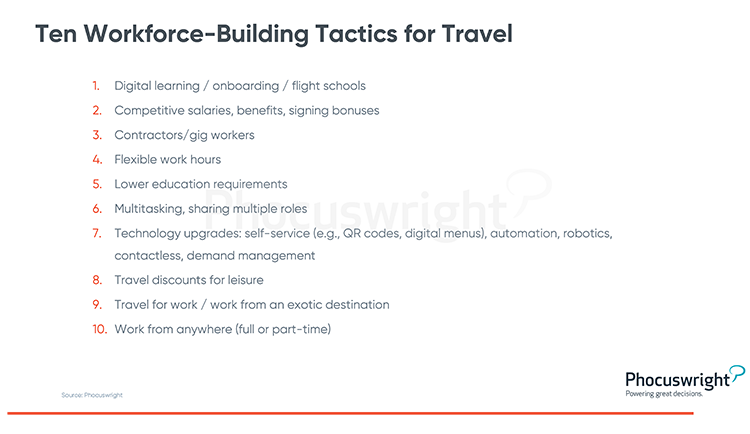Help Wanted: How travel survives the people shortage
- Published:
- August 2022
- Analyst:
- Phocuswright Research
Travel providers were hit hard just when leisure demand began to soar. The result: Some hotels couldn't reopen, and those that did, did so with skeleton crews. According to Phocuswright’s latest travel research report Help Wanted: How Travel Survives the People Shortage, airlines had to cut routes and cancel flights at the last minute because there weren't enough pilots or flight attendants. Other travel businesses have had to reorganize tasks around existing staff while fast-tracking their recruiting efforts.
Soaring demand shouldn't normally be a problem. But an October 2021 survey from the American Hotel and Lodging Association (AHLA) found that 94% of hotels were understaffed and 47% were "severely understaffed" from the lingering crisis. Marriott, for example, had 10,000 vacancies to fill in September 2021 at its 600 managed hotels in the U.S., according to the Financial Times. Even with gradual improvement, the labor pains continue: An analysis for AHLA by Oxford Economics found that hotels are projected to be down by 166,000 workers at year-end, a 7% decline from 2019.
No quick fix
There are myriad solutions for helping airlines, hotels and other travel businesses to rebuild staff - but they are all expensive. The best approach for enticing new talent is money, of course - paying higher wages, whether to an hourly worker or a new manager. (The average hourly earnings for the leisure and hospitality sector is approximately $19.75). With unemployment near an all-time low, workers feel empowered to ask for more cash and benefits, and they're getting it. This creates new problems and can discourage existing (loyal) staff - so they need to be compensated as well. Raises, promotions, benefits (e.g., matching 401K, wellness), and bonuses (including referral bonuses) go a long way. But they still don't solve the problem when competing with so many other industries that historically pay more.
Travel, tourism and hospitality used to be one of the more attractive industries for career building, but that was before the pandemic. still a great place to work, but it has a PR problem. The American Hotel & Lodging Association (AHLA) recently launched an ad campaign touting those advantages, such as traveling to interesting places or obtaining travel discounts. One of its taglines, "Make Everyone's Travel Destination Your Workplace," highlights the allure of travel itself.
As with other industries, travel companies are also promoting the opportunity to work from anywhere, except for employees who do not deal directly (face-to-face) with customers, or who operate a plane, train, tour, etc. Following the pandemic, most workers got used to and still prefer working remotely, even if just a few days a week. Many travel companies can offer that - and many prospective employees demand it. But for companies that need people on the ground, it is harder than ever to attract talented prospects who have more opportunities than ever to work remotely in other industries, often for more compensation.

(Click image to view a larger version.)
This article discusses some of the main challenges faced by the air and hotel segments in restarting and revamping their industries, while balancing the conflicting challenges stemming from high demand, skyrocketing prices and an unprecedented shortage of available workers.
Did you know that you can access this article and Phocuswright’s entire research library with an Open Access subscription? Your entire company gets in on the subscription as well. Our Open Access research subscription puts the world’s most comprehensive library of travel research and data visualization at your fingertips.











